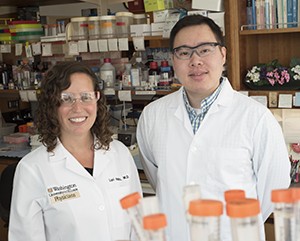 Bacteria aren’t the only nonhuman invaders to colonize the gut shortly after a baby’s birth. Viruses also set up house there, according to new research at Washington University School of Medicine in St. Louis.
Bacteria aren’t the only nonhuman invaders to colonize the gut shortly after a baby’s birth. Viruses also set up house there, according to new research at Washington University School of Medicine in St. Louis.
All together, these invisible residents are thought to play important roles in human health.
The study, published online Sept. 14 in Nature Medicine, reports data from eight healthy infants and is one of the first surveys of viruses that reside in the intestine. The investigators analyzed stool samples to track how the babies’ bacterial gut microbiomes and viromes changed over the first two years of life.
The picture that emerged may be worthy of a wildlife documentary: It includes the discovery of viral strains new to science and suggests a dynamic ecosystem of interacting organisms, including predators and their prey.

“We are just beginning to understand the interplay between all the different types of life within our gut,” said senior author Lori R. Holtz, MD, assistant professor of pediatrics. “They are not stand-alone communities. We also are seeing that the environment of the infant gut is extremely dynamic, which differs from the relative stability that has been shown in adults.”
The earliest stool samples were taken at 1-4 days of life, and even at this early time point, Holtz noted, viruses were present.
“We were surprised that right from the beginning quite a diversity of viruses was found in the gut,” said Holtz, also a pediatric gastroenterologist who treats patients at St. Louis Children’s Hospital. “It prompts the question — where do these viruses come from? We don’t know yet whether diet, method of the baby’s delivery or other environmental influences play a role.”
Analyzing genomic material in the stool samples, the researchers noted that some of the viruses they identified are known to infect cells of the human host, but others actually infect the bacteria.
In fact, the researchers found that the kinds of viruses that infect bacteria, not human cells, were the most rich and diverse earliest in an infant’s life and then their numbers declined. They also showed that strains of bacteria did the opposite, starting out with low numbers early and becoming more diverse as the babies grew into their toddler years.
The investigators suspect that the changes in population dynamics they observed in these viruses and bacteria are caused by a predator-prey relationship. The viruses that exclusively kill bacteria are called bacteriophage, literally “bacteria eater.” The early diversity of bacteriophage means lots of predators with no prey. Since bacteriophage can’t survive without their bacterial prey, the high bacteriophage numbers quickly go down. Faced with few predators, bacteria are then free to flourish and colonize the gut.
“The predator-prey dynamic is still a hypothesis at this point,” Holtz said. “It probably has been best described in bacteriophage and bacteria living in oceans. But this relationship could explain the populations of viruses and bacteria we see, how they change over time and how they may stabilize as we age.”
The researchers also observed a relatively large diversity of a type of virus that infects human cells called anellovirus. Anelloviruses are of interest to researchers because they appear to reflect a person’s immune status, with more viruses present when the immune system is weaker.
“One child had at least 47 anellovirus strains at the 12-month sampling,” Holtz said. “It’s important to remember that these are healthy children living in the community. We wondered if we see a wide diversity of anelloviruses at this age because the children are losing the mother’s immune protection that they have had since birth, and they are still in the process of building up their own immunity in this interval.”
The researchers also noted that almost all of the anelloviruses identified in this study were previously unknown. Such data, originating from only eight babies in St. Louis, hints at the size and difficulty of the task of even determining a healthy baseline for the virome. Such a baseline is required before scientists can understand what roles gut viromes may play in conditions like obesity, diabetes, colitis and Crohn’s disease.
“At this point, we’re just trying to establish what is normal,” Holtz said. “We don’t have enough data yet to know whether a baby’s virome is affected by the environment in the same way that the bacterial microbiome is — through, for example, diet, method of delivery and antibiotic use. We suspect that it is, but that hasn’t been shown.
“So much work is going into understanding how the microbiome affects our long-term health,” she added. “We hypothesize that this important gut environment might be determined when we are infants. Our study is a first look into the dynamic processes that are going on in the gut in early life.”